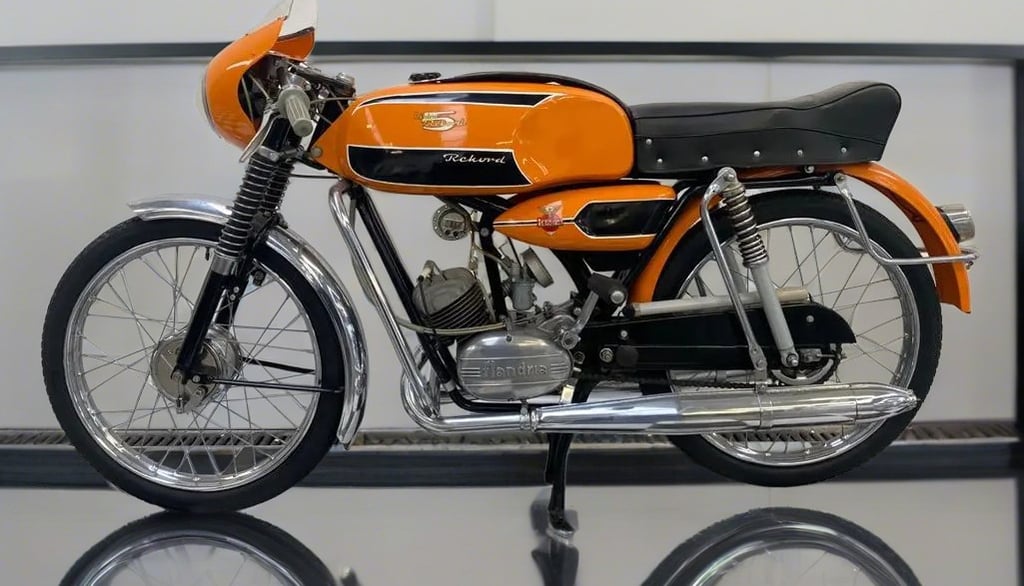Flandria Mopeds: A Belgian Legacy of Innovation and Competition
This article explores the history of Flandria mopeds, a Belgian brand known for its innovation and engineering. It discusses the origins of Flandria, its rise to prominence, the models it produced, and its eventual decline. Despite its demise, Flandria's legacy continues to influence the moped industry today.
BELGIUM 1950'SVINTAGE MOPEDSFLANDRIA
1/28/20242 min read


Flandria Mopeds: A Belgian Legacy of Innovation and Competition
Introduction
Flandria mopeds were not just vehicles; they embodied the spirit of innovation and the Belgian ardor for engineering. As a brand that stood prominently in Belgium and gained recognition beyond its borders, Flandria has left a remarkable imprint in the realm of two-wheeled transport. This article delves into the compelling history of Flandria, from its inception to its peak and eventual decline, giving us a glimpse into the factors that crafted the brand's legacy and led to its demise.
The Genesis of Flandria
The roots of Flandria are as deep and complex as the rich Belgian soil from which it originated. In Zedelgem, Belgium, a blacksmith named Alexander Claeys laid the foundation for what was to become a legendary company. His forge, A. Claeys Flandria, initially focused on crafting a variety of metal products. However, ambition drove the company to expand, and by 1896, it ventured into bicycle manufacturing. The post-World War II era marked a new chapter for the firm, as it embraced the burgeoning trend of motorized bicycles. In 1950, Flandria produced its first mopeds, an endeavor that set the pace for its future successes.
The Glory Days
The ascent of Flandria to a position of prominence within Belgium and across European markets was nothing short of spectacular. As one of Belgium's largest companies specializing in motorcycles, mopeds, and bicycles, Flandria's innovative designs, coupled with a vision for global expansion, saw products shipped to every corner of Europe, North Africa, and even the USA. The family nature of the business was a hallmark of its early success, with the Claeys name becoming synonymous with quality and reliability. The brand’s extensive portfolio included not just two-wheelers, but also stoves, buggies, and even prototypes for cars, showcasing the versatile manufacturing prowess of the Claeys family.
Models and Milestones
Flandria's extensive catalogue of models was characterized by innovation and design flair. Among its many offerings were the Consul, the Bermuda, the Amazone, and the Comet, each with its own unique features and appeal. Some models, like the Caravelle and Floride, were available in both single-speed and varimatic variations. The Imperial model was a luxurious option with fan cooling, dual seating, and weather protection, while the JLO 200cc single showcased Flandria's venture into higher-powered motorcycles. The success of these models was not limited to domestic markets; Bermuda mopeds, in particular, became well-known to tourists in Bermuda, admired for making the island's hilly terrain easily navigable.
Downfall and Demise
A family feud marked the beginning of turbulent times for the Flandria brand. In 1956, a divide formed within the Claeys family, leading to a literal split of the Zedelgem factory, with a brick wall severing the facility and severing relations. Aimé Claeys continued with A.Claeys-Flandria, whereas his brother Remi established Remi Claeys-Superia. This rivalry played out in the marketplace as well, with Superia attempting to mimic Flandria's models, albeit less successfully. During this time, the broader industry was also evolving, with competition increasing and the market for mopeds facing new challenges that may have contributed to Flandria's eventual struggle to maintain its standing.
Legacy and Modern Influence
Flandria's influence extended far beyond its operational years, impacting the design and culture of mopeds for decades. Enthusiasts and collectors today still seek out Flandria models for their timeless aesthetic and exemplary craftsmanship. While the original Flandria has ceased to exist, its legacy endures through the affection and nostalgia it inspires among vintage moped communities around the world. Revival events, rallies, and exhibitions often feature Flandria mopeds, highlighting their enduring appeal and the brand's significant role in shaping the landscape of two-wheeled transportation.
